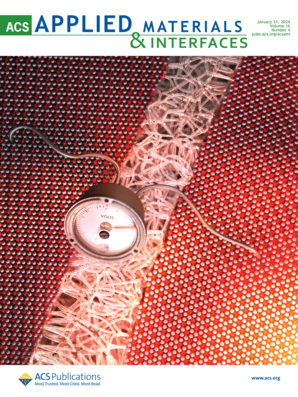Infrared Detection Achieved by Controlling Thermionic Emission in Organic Transistors.
IF 8.3
2区 材料科学
Q1 MATERIALS SCIENCE, MULTIDISCIPLINARY
引用次数: 0
Abstract
Commercial inorganic infrared (IR) photodetectors have important applications in night vision, medical imaging, remote sensing, and other fields, but still face the challenges of operating at low temperatures and high costs. Organic semiconductor (OSC)-based IR detectors can operate at room temperature and have the advantages of flexibility and large-area processing. Consequently, they have important application prospects. However, high-performance OSCs usually have wide bandgaps, which makes it difficult for them to directly absorb IR light for detection. Overcoming the bandgap limitations of OSCs to achieve IR detection is extremely challenging. Herein, the organic field-effect transistors (OFETs) are prepared using poly(3,4-ethylenedioxythiophene):poly(styrenesulfonate) (PEDOT:PSS) electrodes that exhibit photothermal effects under infrared irradiation and can form Schottky contacts with numerous OSCs. The electrodes can effectively absorb IR light and release heat, which increases the temperature of the electrode-OSC contact region and promotes thermionic emission, resulting in a change in the electrical properties of the device to achieve an IR response. Using this strategy, the prepared OFET exhibits a high photosensitivity of 1.42 × 105 and a detectivity of 2.12 × 108 Jones at 808 nm and also exhibits a distinguishable IR response at different light intensities. Moreover, the invisible IR light signal is converted into a visible green light signal via a circuit design. This study provides a universally applicable solution to achieve IR detection using OFETs, which furthers their application potential.控制有机晶体管热离子发射实现红外探测。
商用无机红外(IR)光电探测器在夜视、医学成像、遥感等领域有着重要的应用,但仍面临低温和高成本的挑战。基于有机半导体(OSC)的红外探测器可以在室温下工作,具有灵活性和大面积处理的优点。因此,具有重要的应用前景。然而,高性能OSCs通常具有较宽的带隙,这使得它们难以直接吸收红外光进行检测。克服osc的带隙限制来实现红外探测是极具挑战性的。本文采用聚(3,4-乙烯二氧噻吩):聚苯乙烯磺酸盐(PEDOT:PSS)电极制备了有机场效应晶体管(ofet),该电极在红外照射下表现出光热效应,并能与许多osc形成肖特基接触。电极可以有效地吸收红外光并释放热量,从而提高电极- osc接触区域的温度,促进热离子发射,从而改变器件的电学性能,从而实现红外响应。利用该策略制备的OFET在808 nm处具有1.42 × 105的高光敏性和2.12 × 108琼斯的探测率,并且在不同光强下也具有可区分的红外响应。此外,通过电路设计将不可见的红外光信号转换为可见的绿光信号。本研究为利用ofet实现红外探测提供了一种普遍适用的解决方案,进一步拓展了ofet的应用潜力。
本文章由计算机程序翻译,如有差异,请以英文原文为准。
求助全文
约1分钟内获得全文
求助全文
来源期刊

ACS Applied Materials & Interfaces
工程技术-材料科学:综合
CiteScore
16.00
自引率
6.30%
发文量
4978
审稿时长
1.8 months
期刊介绍:
ACS Applied Materials & Interfaces is a leading interdisciplinary journal that brings together chemists, engineers, physicists, and biologists to explore the development and utilization of newly-discovered materials and interfacial processes for specific applications. Our journal has experienced remarkable growth since its establishment in 2009, both in terms of the number of articles published and the impact of the research showcased. We are proud to foster a truly global community, with the majority of published articles originating from outside the United States, reflecting the rapid growth of applied research worldwide.
 求助内容:
求助内容: 应助结果提醒方式:
应助结果提醒方式:


